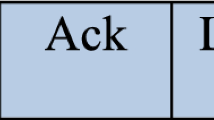Abstract
The existing methods of data transmission via covert channels in IP networks and methods to counter them are analyzed and systematized. The focus is placed on direct and indirect covert channels resistant to many methods of detection and elimination. It has been concluded that the studies aimed at limiting the covert channel capacity without a significant reduction of the communication channel capacity are promising.
Similar content being viewed by others
References
GOST (State Standard) R 53113.1-2008: Information Technology. Protection of Information Technology and Automated Systems of Information Security Threats Implemented through Covert Channels. Part 1: General Provisions, 2008.
Cabuk, S., Network covert channels: Design, analysis, detection, and elimination, PhD Dissertation, Perdue University, 2006.
Zander, S., Armitage, G., and Branch, P., A survey of covert channels and countermeasures in computer network protocols, the future of identity and information society, IEEE Commun. Surv., 2007, vol. 9, no. 3.
Matveev, S.V., Avoiding closed channels in automated systems and their capacity in some counteraction meethods, Dokl. TUSURa, Mat. Obosnov. Teor. Aspekty Inf. Bezop., 2012, no. 1 (25), part 2.
Kiraly, C., Teofili, S., Bianchi, G., Lo Cigno, R., Nardelli, M., and Delzeri, E., Traffic flow confidentially in IPsec: Protocol and implementation, The International Federation for Information Processing, 2008, vol. 262.
Hussain, M., High bandwidth covert channels in network protocol, Int. J. Adv. Sci. Technol., 2011, vol. 30.
Zander, S., Armitage, G., and Branch, P., Covert channels in IPtime to live field, Proceedings of the Australian Telecommunication Networks and Applications Conference, 2006.
Rowland, C.H., Covert channels in the TCP/IP protocol suite, First Monday, 1997, vol. 2, no. 5.
Danezis, G., Covert communications despite traffic data retention, Proceedings of the Sixteenth International Conference on Security Protocols, 2008.
Luo, X., Chan, E.W.W., and Chang, R.K.C., TCP covert timing channels: Design and detection, Proceedings of the 2008 IEEE/IFIP International Conference on Dependable Systems and Networks, 2008.
Berk, V., Giani, A., and Cybenko, G., Detection of Covert Channel Encoding in Network Packet Delays: Technical Report TR2005-536, New Hampshire: Thayer School of Engineering of Dartmouth College, 2005.
Sellke, S.H., Wang, C.-C., Bagchi, S., and Shroff, N.B., Covert TCP/IP timing channels: Theory to implementation, Proceedings of the Twenty-Eighth Conference on Computer Communications, 2009.
Kundur, D. and Ahsan, K., Practical Internet steganography: Data hiding in IP, Proceedings of the Texas Workshop on Security of Information Systems, 2003.
Murdoch, S.J., Hot or not: Revealing hidden services by their clock skew, Proceedings of The Thirteenth ACM Conference on Computer and Communications Security, 2006.
Arkhangel’skaya, A.V. and Kogos, K.G., On the approach to counter the diversion of information through hidden channels, Bezop. Inf. Tekhnol., 2013, no. 4.
Arkhangel’skaya, A.V., Arkhangel’skii, V.G., and Kalmykov, V.V., On the development of the gateway architecture for unidirectional guaranteed data transfer, Sb. Materialov 22-i nauchno-tekhnicheskoi konferentsii “Metody i tekhnicheskie sredstva obespecheniya bezopasnosti informatsii” (Proc. 22th Sci.-Tech. Conf. Methods and Technical Tools of Information Security), St. Petersburg: Izd-vo Politekhn. Univ., 2013, pp. 52–55.
Wei-Ming, H., Reducing timing channels with fuzzy time, Proceedings of the IEEE Computer Society Symposium of Research in Security and Privacy, 1991.
Smith, R.W. and Knight, G.S., Predictable design of network-based covert communication systems, Proceedings of the IEEE Symposium on Security and Privacy, 2008.
Venkatraman, B.R. and Newman-Wolfe, R.E., Capacity estimation and auditability of network covert channels, Proceedings of the IEEE Computer Society Symposium of Research in Security and Privacy, 1995.
Grusho, A.A., Hidden channels and information security in computer systems, Diskretn. Mat., 1998, vol. 10, no. 1.
Grusho, A.A., On the existence of covert channels, Diskretn. Mat., 1999, vol. 11, no. 1.
Author information
Authors and Affiliations
Corresponding author
Additional information
Original Russian Text © A.V. Epishkina, K.G. Kogos, 2015, published in Problemy Informatsionnoi Bezopasnosti. Komp’yuternye Sistemy.
About this article
Cite this article
Epishkina, A.V., Kogos, K.G. Study of countermeasures against covert channels in IP networks. Aut. Control Comp. Sci. 49, 785–789 (2015). https://doi.org/10.3103/S0146411615080064
Received:
Published:
Issue Date:
DOI: https://doi.org/10.3103/S0146411615080064




